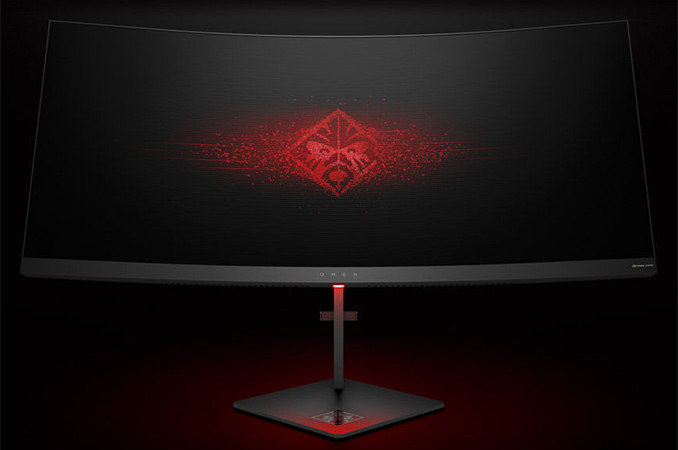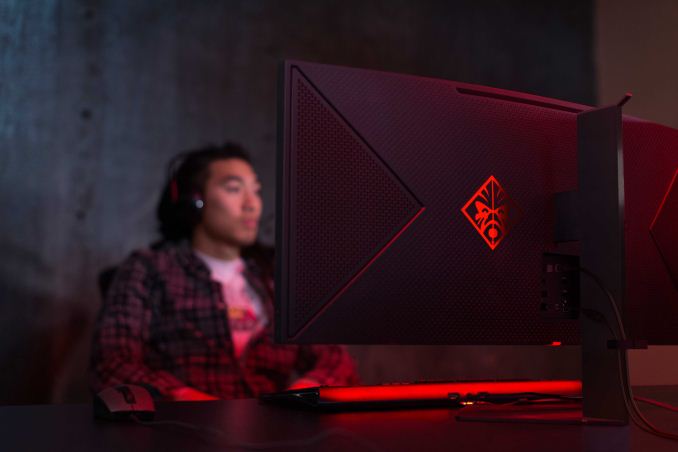HP Announces Omen X 35-Inch Curved Display for Gamers
by Anton Shilov on January 6, 2017 11:50 AM EST
HP at CES introduced its first ultra-wide curved display for gamers that belongs to the company’s Omen X lineup. The unit will be among the largest monitors from HP and also the company’s first one to support NVIDIA’s G-Sync technology. The release of the Omen X 35” screen emphasizes growing importance of gaming hardware for HP.
The HP Omen X 35” display is based on an AMVA+ panel with 3440×1440 resolution, 300 nits brightness, 1800R curvature, a 2500:1 contrast ratio, a 100 Hz refresh rate and a 4 ms response time, which makes for an interesting combination of characteristics. To smooth the gaming process, the monitor supports NVIDIA’s G-Sync technology, but the maker does not disclose supported working range of the tech. HP says that the monitor can reproduce 16.77 million colors and supports 100% of sRGB color gamut, which is something logical to expect from a gaming display that will run primarily Microsoft Windows.
| HP Omen X 35" Specifications | |
| X3W57AA#ABA | |
| Panel | 35" AMVA+ |
| Native Resolution | 3440 × 1440 |
| Maximum Refresh Rate | 100 Hz |
| Response Time | 4 ms GTG |
| Brightness | 300 cd/m² |
| Contrast | 2500:1 |
| Viewing Angles | 178°/178° horizontal/vertical |
| Curvature | 1800R |
| Color Gamut | 100% sRGB |
| Dynamic Refresh Rate Tech | NVIDIA G-Sync |
| Pixel Pitch | 0.2382 mm × 0.242 mm |
| Pixel Density | 106 PPI |
| Inputs | 1 × DP 1.2 1 × HDMI 1.4 |
| Audio | 3.5 mm input/output |
| USB Hub | 3 × USB 3.0 Type-A connectors 1 × USB 3.0 Type-B input |
| Power Consumption | Idle: 0.5 W Active: 120 W |
| Link | X3W57AA#ABA |
For connectivity, the Omen X 35” can use either a DisplayPort 1.2 or an HDMI 1.4 input. In addition, the monitor has a three-port USB 3.0 Type-A hub, an audio input and a headphone jack. Since the HP Omen X 35” is a premium monitor for gamers, it does not have integrated speakers because the majority of gamers use standalone audio systems or headphones.
HP will position its Ultra WQHD Omen X 35” as its top-of-the-range monitor for gamers and will price it accordingly, at $1300 when it becomes available in March. Curvature, 21:9 aspect ratio, thin bezel and NVIDIA’s G-Sync technology will be the main selling points of the monitor. At present, there is only one competing display with 3440×1440 resolution and similar features (the ASUS ROG SWIFT PG348Q), so, HP’s offering will be comparable with its direct rival and ahead of other suppliers. Meanwhile, the display will be covered by HP’s one-year limited warranty, which is considerably shorter than other suppliers of monitors provide.
- Acer Introduces A Pair Of Predator Gaming Displays
- ASUS VA326H and VA326N-W: 31.5-Inch Curved 144 Hz FHD Displays for $399
- Samsung CFG70: Curved 144Hz Displays with Quantum Dot Backlighting and AMD FreeSync
- Dell Unveils UltraSharp U3417W: Makes Its Curved Display More Curved
- LG Announces the 34UC79G: 34-Inch Curved 21:9 Display with 2560 × 1080 Resolution, 144 Hz Refresh Rate for $700
- LG 38UC99 Announced: 37.5-Inch Curved 21:9 Display with 3840×1600 Resolution
Source: HP

















44 Comments
View All Comments
Murloc - Friday, January 6, 2017 - link
how does AMVA+ compare to TN and IPS?DanNeely - Friday, January 6, 2017 - link
*VA panels are much closer to IPS than to TN. Their main advantage over IPS was higher contrast. Off axis viewing angles were IPS like, but looked at dead on they suffered from black crush (basically black and the darkest grays all looked the same). Their main historic liability was that they generally had the worst input lag (although a lot of this was due to the LCD controllers not the panel itelf); something I would assume isn't an issue with this one being marketed as a gaming display.Laststop311 - Sunday, January 8, 2017 - link
VA panels have come a long way. Samsung makes a 1920x1080 VA panel that is 144hz and has very good pixel response time and AMD freesync 35hz-144hz range. It also has quantum dots for 125% sRGB coverage. Me personally I like that its 27 inches and 1080p resolution. I do not have to use any DPI scaling so everything looks proper and i get faster smoother gaming with more frames to make use of the 144hz than i would get with 1440p. The Samsung doesn't crush the dark details either. It's total input lag including the controller and pixel time is only 7ms which tftcentral rates as excellant. It's 3000:1 contrast ratio is excellant and it does not suffer from backlight bleed on the edges and no dreaded IPS glow since it's not an ips. This VA panel is within 1ms of pixel response to the IPS asus rog swift. It's a really great monitor for 450 dollars. It will probably be my next choice.Laststop311 - Sunday, January 8, 2017 - link
I thnk samsung just released this panel only a few months ago. So it is the latest tech in VA panels.Laststop311 - Sunday, January 8, 2017 - link
acer also uses this panel for a g sync monitor if you have nvidia. It's an extra 130 dollars over the samsung and has no quantum dots tho.TristanSDX - Friday, January 6, 2017 - link
some pixel transitions in VA panels are very slow, so there is noticeable trailing, and colors are somewhat pale than in IPSlmcd - Saturday, January 7, 2017 - link
That's a little unclear as panels with overdrive settings often (to my eyes) do quite well reducing ghosting. I personally think the cheap BenQ panels I have do almost as well as a recent Asus IPS I purchased (the BenQ were $100 21.5in FHD panels, the Asus is a $400 4k IPS).Michael Bay - Sunday, January 8, 2017 - link
Check it on some kind of dark violet/purple and you`ll see the difference clearly. I was completely happy with my Benq before I did, now not so much.Still much better than TN, of course.
Wolfpup - Monday, January 9, 2017 - link
Well VA TVs sure beat IPS. WAAAAAAAAAAAAAAAAAAAY more contrast and they're really fast too (although for a VA panel this doesn't have much contrast...though still like double what "good" IPS usually has).VA's the only tech I want in any of my displays anymore, save, I guess, for my iPad, since you use that from different orientations.
skypine27 - Sunday, January 8, 2017 - link
How is this an improvement (and in fact, a step behind!!) over the 34" 3440 x 1440 IPS, 100hz. G-sync Acer x34??I've been an x34 user since day one and this new HP seems like a step backwards.
Now if it was 120 or 144hz And still 3440 x1440, that would be a different story.